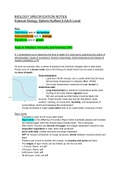Summary
Edexcel Biology A (Salters-Nuffield): Topic 6 IIF (Infection, Immunity and Forensics) summary
- Institution
- PEARSON (PEARSON)
This is a summary of every learning objective (6.1-6.15) for Topic 6 IIF, on the Edexcel Biology A (Salters-Nuffield) specification. I have arranged my notes answering each objective, and have given definitions, core practical information, and equations, based from the textbook. These notes inc...
[Show more]



